
Incheon, formerly Jemulpo or Chemulp'o (제물포) until the period after 1910, officially the Incheon Metropolitan City, is a city located in northwestern South Korea, bordering Seoul and Gyeonggi to the east. Inhabited since the Neolithic, Incheon was home to just 4,700 people when it became an international port in 1883. Today, about 3 million people live in the city, making it South Korea's third-most-populous city after Seoul and Busan.

The Gyeongin Line (Gyeonginseon) is a railway mainline in South Korea, currently connecting Guro station in Seoul and Incheon. Commuter services along the line through operates into Seoul Subway Line 1.
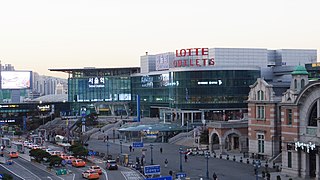
Seoul Station (Korean: 서울역) is a major railway station in Seoul, the capital of South Korea. The station is served by the Korail Intercity Lines and the commuter trains of the Seoul Metropolitan Subway.

Bucheon is a city in Gyeonggi Province, South Korea. Bucheon is located 25 kilometers (16 mi) away from Seoul, of which it is a satellite city. It is located between Incheon and Seoul.

Seongnam is the fourth largest city in South Korea's Gyeonggi Province after Suwon and the 10th largest city in the country. Its population is approximately one million. Seongnam is a satellite city of Seoul. It is largely a residential city located immediately southeast of Seoul and belongs to the Seoul Capital Area.

Seoul Subway Line 7 of the Seoul Metropolitan Subway was built from 1990 to 1996 and was completed on August 1, 2000 ; the western section between Sinpung and Onsu was put into service on February 29, 2000. This north-south line does not run through the city centre but links Gangnam directly to the northeastern districts of Seoul. In 2019, Line 7 had an annual ridership of 380 million or 1.04 million passengers per day. Although most trains run between Jangam and Seongnam, some trains short turn at Onsu station and some trains start at Dobongsan station.
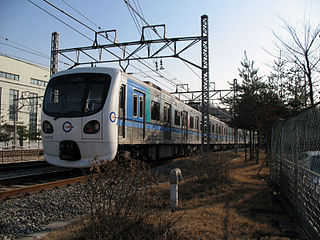
The Incheon Subway is a subway system serving the South Korean city of Incheon. The system is operated by Incheon Transit Corporation, and is part of the greater Seoul Metropolitan Subway.

Incheon Subway Line 1 is a 29.4-kilometer (18.3 mi) north-south subway line, part of the Incheon Subway system. The line is also included as a part of the overall Seoul Metropolitan Subway network; Bupyeong Station has a free transfer with Seoul Subway Line 1, Gyeyang Station connects with the AREX Line which leads to Incheon International Airport and Seoul Station, Bupyeong-gu Office Station has a free transfer with Seoul Subway Line 7, and Woninjae Station has a free transfer with the Suin-Bundang Line.
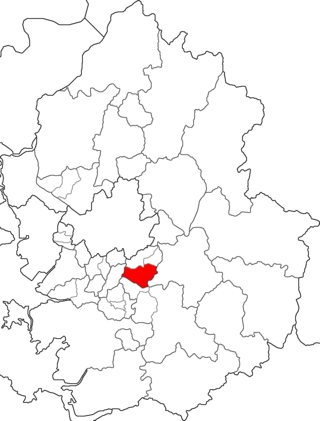
Bundang-gu (Korean: 분당구) is the largest and most populous district (gu) of Seongnam, a major city in the Seoul Capital Area, South Korea. Bundang-gu is one of South Korea's wealthiest and highest developed areas, being the nation's first and largest completely artificial city built in the early 1990s. Many high-rise luxury condos moved in the early 2000s, with a second planned city built in the late 2000s called Pangyo in the same district. Apartment prices are the second highest in Gyeonggi-do after Gwacheon and 7th highest nationwide, higher than many central Seoul districts such as Mapo-gu or Jongno-gu. Apartments around Pangyo station and the high-rise luxury condos around Jeongja station and Sunae station rival prices in the most expensive areas in the country. Unlike older cities such as Seoul, Bundang has no telephone poles overground, resulting in a clean cityscape with well-designed streets.

AREX is a South Korean airport rail link and commuter rail line that links Incheon International Airport with Seoul Station via Gimpo International Airport. The section between the two airports opened on March 23, 2007, and line was extended to Seoul Station on December 29, 2010. Long-distance Korea Train Express high speed trains started to use the line from June 30, 2014, but discontinued service in March 2018 due to low ridership.
Seoul, the capital and largest city in South Korea, accounts for only 0.6% of the country's total land area, yet it is home to around 19% of the population. The population density in Seoul demands a great deal of the city's transportation systems, which are regarded by many as among the best and most advanced in the world. Seoul is very well connected by its subway and bus systems, and the city is also very supportive of pedestrian foot travel. In 2006 it won the Sustainable Transport Award.
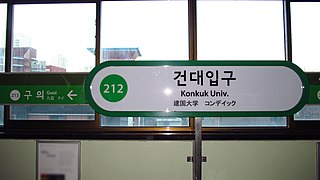
Konkuk University Station is a rapid transit station on Seoul Subway Line 2 and Seoul Subway Line 7. It is located in Hwayang-dong in the Gwangjin-gu administrative district of Seoul. It is adjacent to Konkuk University from which it takes its name. Line 2 is serviced by an elevated platform while Line 7 is serviced by an underground platform. The station has connections to ten bus lines through its six exits as well as a connection to the airport shuttle bus. The station services Hwayang-dong as well as Jayang-dong and Noyu-dong. The area around the station is mixed residential and small commercial businesses. Exits from the underground Line 7 platform open into Konkuk University and the adjacent Star City shopping and high-rise residential tower complex.
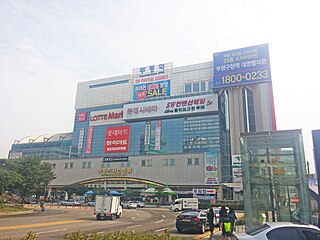
Bupyeong station is a subway station located in Bupyeong District, a district in Incheon, South Korea. This station is on the Seoul Subway Line 1 and Incheon Subway Line 1. It is one of the busiest stations on the Incheon line because of its central location and its connection to the Seoul line.

Oido station is a subway station on Seoul Subway Line 4 and the Suin–Bundang Line in Siheung, South Korea. It is the current southwestern terminus of Seoul Subway Line 4 located almost 30 kilometers southwest of Seoul, connecting Oido to other parts of Korea. A commuter rail trip between this station and Seoul Station takes over an hour, and a train servicing depot is located nearby. The name of the station was decided by the surrounding area Oido island.

Incheon Subway Line 2 is a driverless, medium-capacity subway line running 29.2 km (18.1 mi) from Oryu-dong in Seo-gu to Incheon Grand Park, with 27 stations, part of the Incheon Subway system. The line is also included as a part of the overall Seoul Metropolitan Subway network; Juan station has a free transfer with Seoul Subway Line 1, Geomam station connects with the AREX Line to Incheon International Airport and Seoul Station, and Seongnam also has a free transfer with Seoul Subway Line 7.

The Gyeonggang Line (경강선) is a rail line in South Korea, which at present comprises two distinct sections. The first one, which opened on September 24, 2016, is part of the Seoul Metropolitan Subway system in Gyeonggi Province, South Korea, and runs from the city of Seongnam to Yeoju City, partially coinciding with the route of the former narrow-gauge Suryeo Line. The second section, which is located entirely in Gangwon Province, runs between Gangneung and Wonju and opened on December 22, 2017, in anticipation of the 2018 Winter Olympics. This section of the line offers KTX service from Seoul, through the Jungang Line. In the future, the two sections are to be connected, and the Gyeonggang Line will be extended westwards to Siheung.

Incheon Transit Corporation (인천교통공사), formerly known as Incheon Rapid Transit Corporation (인천지하철공사) currently operates the Incheon Subway, Wolmi Sea Train, Incheon Bus information, Incheon Bus Terminal, Call taxi for the handicapped in Incheon, South Korea, established in 1993. In 2011 Incheon Transit Corporation merged with ′Incheon Metro′, established in 1998 to operate Incheon Subway Line 1, Incheon Subway Line 2, the section of Seoul Subway Line 7 between Kkachiul & Seongnam, & the Incheon Airport Maglev. In the future it also has plans to operate Line 3.
Nonhyeon can refer to several places in South Korea.
Sinheung station may refer to these railway stations in South Korea:

Seongnam Station (석남역) is a subway station on Incheon Subway Line 2 and Seoul Subway Line 7. It first opened as a station on Incheon Subway Line 2 solely in 2016, and Seoul Subway Line 7 opened in May 2021. Despite their identical spelling in the Roman script, the station is not located in the city of Seongnam (성남) southeast of Seoul, as their names in Hangul differ by one letter.















